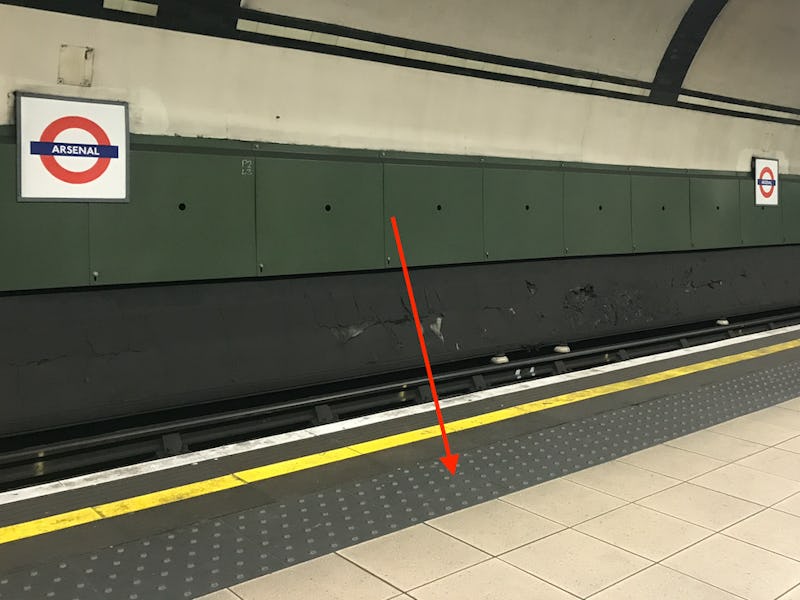Seiichi Miyake: 5 Brilliantly Simple Uses for His "Tenji Blocks"
Inclusive design led to safer streets.

If you have ever taken public transportation, cruised through a city on a bicycle, or even simply crossed the street, you can thank the Japanese inventor Seiichi Miyake for helping you get from point A to point B safely.
That’s because Miyaki is credited with inventing the ribbed, yellow squares of pavement that warn pedestrians to stand back from the edge of a train platform, known as “Tenji blocks.” Monday marks the 52nd anniversary of the first Tenji block installment in Okayama City, Japan, and Google marked the occasion with a front-page doodle.
Miyake originally came up with the idea for tactile paving to help a friend who was losing their vision. To help his friend get around, Miyake contrived a system of blocks — that walkers can feel either through shoes or with the help of a cane — that urban planners could arrange near street ledges or on subway platforms. But as is often the case with inclusive design, what started as an improvement to help the visually impaired was soon appreciated as having other virtues.
The Google Doodle honoring Seiichi Miyake, inventor of tactile blocks.
Here are five ways that Tenji blocks —which get their name from a Japanese system of braille — have transformed pedestrian and cyclist safety in cities and towns around the world, whether you’re visually impaired or not.
Two drafts of the doodle that appeared on Google's homepage.
5. Bicycle Lanes
Miyake’s original design included square bundles of bumps raised around five millimeters off the ground. But since then, more subtly ribbed blocks and bars have also been implemented to help develop multi-use pedestrian spaces, for example using the different textures to delineate which part of a sidewalk is designated for bikers or foot traffic.
Retail parks in Dublin all split their sidewalks in half using a central bar, with ribbed blocks running vertically in the bike lane and horizontally in the pedestrian lane. This way, cyclists who veer into the pedestrian lane ride over a series of speed bumps to remind them to switch lanes.
Retail park in Dublin uses tactile paving to split its sidewalks into pedestrian and cycling lanes.
“These units tend to be used in those projects where there is no curb or other strong demarcation between a footpath and the cycleway,” explains paving and hard-landscaping consultant site Paving Expert.
4. Flights of Stairs
Horizontally positioned, rounded rods are known as “corduroy paving” when used on their own to delineate an impending drop. This kind of tactile paving is used most often at the top and bottom of staircases and are often times painted a different color from the rest of the surrounding concrete to help them stand out more.
An example of hazard paving at the bottom of a staircase.
This lets the visually impaired feel where a staircase begins and ends, and also gives clear visual markings as to how high a flight of stairs may be.
3. Sidewalk Paving
Crowded pedestrian marketplaces or malls can be difficult to navigate, particularly at maximum capacity. But in certain parts of the world, you can simply look down for directions thanks to tactile sidewalk paving. This form of guidance works similarly to the ribbed pavement used in bike lanes, but are specifically meant to help pedestrians figure out if they should bear left or right, for example, to help keep foot traffic moving.
Tactile paving in a Vietnamese shopping area.
They are almost always a different color than the rest of the bricks or pavement that surround them, and they are used to visually reflect a change in direction when a path veers to the left or right.
2. Buses, Rails, and Tram Markings
For a majority of the public transportation that takes place on streets, for example buses, rails, and trams, stops are usually marked off using lozenge paving. These blocks look a lot like a cluster of cough drops and are used to mark where a bus is supposed to stop.
Charcoal lozenge paving at a tram stop in Dublin.
Lozenge paving looks very similar to Miyake’s original design, but makes use of slightly larger bumps. This way everyone knows where a tram will come to a stop, and they can stand clear of the oncoming traffic.
1. Train Stations
Finally, the most iconic use of tactile paving is usually seen in train stations both above and underground. The blocks typically used are identical to the invention Miyake coined more than 52 years ago, and have become known as offset blisters.
Two rows of offset blisters are placed on MTA platforms in the New York City subway system.
You can find offset blisters buffering the area between a platform and railway tracks. They serve to indicate “how close is too close” when waiting for a train, and are also usually painted bright yellow to remind everyone to mind the gap.
So the next time you, say, board a subway train or ride your bike on a boardwalk peacefully alongside pedestrians on an evening stroll, remember that it’s thanks in part to Miyake’s Tenji blocks that everyone can get where they’re going safely.